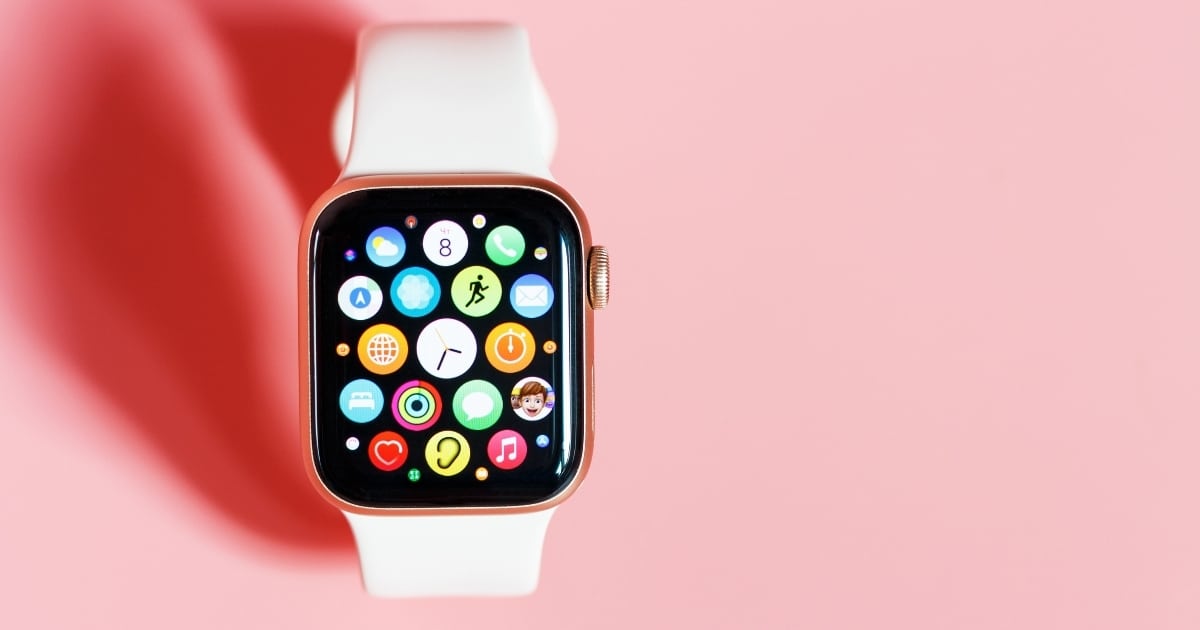This post may contain affiliate links. Please read our disclosure.
Smartwatches can be a great tool to help people living with diabetes keep a healthy lifestyle.
These devices can help you manage your diet, heart rate, calorie intake, and even your stress levels.
Smartwatches cannot currently monitor blood glucose levels directly, and the FDA has warned against using watches or rings that claim to be able to measure blood sugar. However, you can link external CGM (continuous glucose monitoring) systems to your smartwatch to get blood sugar readings.
I have done a lot of research to find the best smartwatches for people with diabetes and answer some of the most common questions about smartwatches.

Table of Contents
Smartwatch review
These are the, in my opinion, five best smartwatches for people living with diabetes currently on the market:
Fitbit is known for its high-performing fitness watches, and the Fitbit Sense is no exception!
Fitbit doesn’t have any official CGM watch faces, but you can still get your blood sugar on your watch by using a third-party CGM watch face.
I recommend using Glance to display Dexcom CGM readings, a free watch face.
The Fitbit Sense lets you print a PDF of your well-being statistics to show your doctor. The software is simple and fast, while the watch itself can last for 6+ days without charging.
You can use Fitbit Sense to set and track diet plans, as well as calories burned. It also has a few sports profiles that let you track your training, along with a GPS that can give you more information about your outdoor activities.
- Connects with third-party CGMs – Displays blood glucose levels and trends
- Fairly accurate ECG app – accurately measures heart rate and rhythm
- Simple, sleek design – Suitable for a range of styles and professions
- Relatively affordable option
- Doesn’t link with many third-party apps
- No official CGM watch faces
- To view your CGM data you still need to bring your phone with you
Apple has a lot of apps that can help people living with diabetes manage their condition, like Sugar Sense, Glucose Buddy, and Diabetes Tracker.
More importantly, you can link the watch with a Dexcom CGM to view your blood sugar data, even if you don’t have your iPhone with you. It’s the first, and currently only smartwatch that connects directly with Dexcom through the official Dexcom app.
You can also link other CGM brands like the Freestyle Libre to your Apple Watch through third-party apps such as LibreWatch and Nightguard.
The Apple Series 9 also manages important health issues and its ECG is considered accurate and will notify you of any heart rate irregularities.
Poor sleep can negatively affect those with diabetes, but the Series 9 comes with sleep-tracking features to help support your overall health.
The Series 9 has 18 hours of battery life and 36 hours in low-power mode. It will allow you to make calls and receive messages even when you don’t have your phone nearby.
- Connects to Dexcom CGM – Lets you view your blood sugar data on your wrist
- Only smartwatch to link directly to the Dexcom CGM (Apple watch 6 or newer)
- Large durable display – Screen is easy to read and resists damage well
- More expensive than other watches that have similar features
The Samsung Galaxy 6 is made to last with a sapphire crystal glass face.
This smartwatch lets you see your Dexcom blood sugar readings and trends over time. The watch connects to your Android phone and you still have to bring that with you to see your readings on your watch.
The Galaxy 6 also has many watch faces to choose from and includes features such as sleep coaching and the Bioelectrical Impedance Analysis Sensor (BIA) that reads your body fat, skeletal muscle, body water, and basal metabolic rate.
The watch will automatically detect many popular activities like running and swimming and use its GPS feature to track outdoor sports. The Galaxy 6 also offers features enhanced GPS with voice navigation right on your wrist.
- Connects to Dexcom CGM (with third-party app)
- Enhanced body composition analysis, including body mass and metabolic rate
- Advanced sleep coaching
- Some features are exclusive to the Samsung ecosystem
Garmin smartwatches are a solid competitor to Apple watches for those who do not want an Apple product.
Garmin offers an official Dexcom widget, so you can see your blood sugar readings directly on your Garmin Venu 4 if you have a compatible smartphone.
It has a lot of health features relevant for people living with diabetes, such as a heart rate monitor, abnormal heart rate alerts, stress monitoring, relaxation reminders, and sleep coach functionality.
It also offers a pulse oximeter that measures how much oxygen is in your bloodstream as well as an ECG.
Garmin Venu 4 has a battery life of 11 hours and up to 14 days if the watch is kept in smartwatch mode.
It’s “swim-proof” and you can make calls and send text messages directly from the watch.
- Connects to Dexcom CGM – Lets you view your blood sugar data on your wrist
- Many high-tech features
- Ideal for tracking many types of exercise
- Bulky watch
- Battery life can be short
TicWatch’s Pro 3 SmartWatch is ideal for those pursuing a healthy lifestyle. It has several sports modes and a 24-hour heart rate monitoring feature that are great for those wanting to improve their fitness.
This model has 8GB of internal memory that can store many apps and songs. You can also choose between two modes to make the battery last longer, with the primary mode delivering 45 days of battery life.
This model works well with Dexcom CGMs through the XDrip app.
You can look at your energy intake, heart rate, blood oxygen, and sleep satisfaction. The watch can also link with apps like MyFitnessPal and MapMyRun to track food intake and exercise levels.
Buying guide
Can smartwatches reliably show health data?
Smartwatches can display your blood glucose levels but won’t measure them themselves. They need to be linked with an external CGM system to acquire blood glucose information and are as accurate and reliable as the CGM you use.
Except for Apple watches 6 and newer, you will still need to carry your phone as the watches have to connect to your phone to display your blood sugar readings.
Other than blood glucose data, smartwatches can help people with diabetes manage a healthy lifestyle. They can look at your calorie intake, diet plan, heart rate, sleep patterns, and stress levels.
These benefits sound amazing, but remember, none of these devices will be 100% accurate. Nevertheless, opting for a brand like Samsung, Fitbit, Garmin or Apple is a good idea. These will be more expensive, but their devices will be more accurate than cheaper options.
In most cases, obtaining a more reliable smartwatch will mean you’ll have to part with more money.
Additionally, a smartwatch’s accuracy will vary with the watch’s location and your wrist steadiness. When you measure your heart rate or blood pressure, you should aim to keep your arms and wrists as stable as you can.
Any movement can affect the measuring process and may deliver inaccurate results.
Current CGM devices that link with smartwatches
Here are some of the CGM devices that can currently link to smartwatches. You should consider these options before purchasing your smartwatch.
Dexcom G6 & G7
Dexcom’s G6 and G7 models are the brand’s most up-to-date glucose monitors. They use a sensor to continually measure glucose over a ten-day term. The sensor has a small needle that reaches interstitial fluid under the skin, held in place with an adhesive patch on the skin’s surface.
Both models can connect directly to smartwatches. They can also send this information to Android and iPhone smartphones through Bluetooth.
They will monitor glucose levels and send alerts when they are too low. They are FDA-approved and suitable for anyone over the age of 2, so both adults and children can wear them.
Freestyle Libre 2 & 3 (and 3 PLUS)
The Freestyle Libre measures interstitial fluid to deliver blood sugar data like the Dexcom.
It’s a real-time CGM sending your blood sugar readings to a designated receiver or phone app and can display data on many smartwatches.
The Freestyle Libre 2 and 3 sensors will last for 14 days before they need replacing, and Libre 3 PLUS will last 15 days.
Freestyle Libre 2 is indicated for age 2 and older and Freestyle Libre 3 is indicated for age 4 and older.
Ways smartwatches can help people living with diabetes
Here are some of the advantages smartwatches can have for those living with diabetes.
Lets you manage your condition
One of the best ways of controlling diabetes is through maintaining a healthy lifestyle. Smartwatches can be a great tool that lets you look after your well-being.
Smartwatches linked to a blood glucose monitoring system are one of the simplest ways of doing so.
These devices can act as a consistent medical checkup. For instance, if your blood sugar lowers or rises too much, you’ll get an alert on your smartwatch, indicating that you need to take action.
Reads blood sugar levels quickly and discreetly
Traditional blood glucose detection methods can take time to carry out. Smartwatches linked with CGMs allow you to check your blood sugar quickly and efficiently by just glancing at your wrists.
This can be very convenient in meetings, social gatherings, and other places where you may prefer to check your blood sugar discreetly.
It is also very practical when exercising, driving, or doing anything else where you don’t want to stop to check your blood sugar on your phone or with a finger stick.
More socially acceptable than checking your phone
You may be able to check your blood sugar through your smartphone, but there are many instances where checking your phone isn’t acceptable.
You may be driving your car, in a meeting, or if younger, maybe in school. Checking your phone isn’t very discreet, and may result in penalties when on the road or during class.
Smartwatches can deliver a notification without playing sounds on the user’s phone. Some offer a vibrate option that won’t be noticeable to others.
You simply have to glance at your wrist to keep an eye on the numbers, without looking disrespectful of your surroundings.
Smartwatches also allow you to check your blood glucose without being distracted by other smartphone apps. This is ideal if you want to improve your productivity, as you can use your smartwatch to check your blood sugar while working.
What to look for when purchasing a smartwatch
Other than your choice of CGM, there are other things people living with diabetes should consider before buying a smartwatch.
Take a look at the rest of our handy buyer’s guide below to see what you should look out for!
Accuracy
Accuracy is more of an issue with your CGM, as this will be the device that measures your blood glucose. Despite this, accuracy also matters when considering other metrics, like heart rate or blood oxygen.
You need as accurate information as possible to get a better understanding of your health. This will let you know where you are making progress and where you need to improve.
All of this helps maintain a healthy lifestyle, which is key when living with diabetes.
Features
Other than linking to a CGM, your smartwatch should have a range of health features that help you with your well-being. Features like measuring heart rate and calorie intake can help you keep fit.
Higher-end smartwatches may have features like measuring blood oxygen, though this might not be necessary, depending on your needs.
Your budget will be a factor that determines what features your watch will have, but basic models should still have a decent selection of health features.
Design
Smartwatches tend to be designed with comfort in mind, but you should make sure that your choice isn’t too heavy on your wrist.
You’ll also need to make sure that your smartwatch isn’t too large or small for your needs. This mainly depends on your build, but your lifestyle affects this too.
Athletes and those who exercise often may need a bolder design, while working professionals may prefer a sleeker look.
The watch face also matters. There’s no point in buying a smartwatch if you keep squinting to read it!
Battery Life
It’s important to buy a smartwatch with a long life span, especially if you will be wearing the smartwatch almost constantly to get CGM readings.
Your smartwatch should have a decent battery life so you won’t have to keep charging it too often.
Recharging time also matters, as your model shouldn’t need to take most of the day to fully recharge.
Water Resistance
Whether you’re washing your hands or taking a dip in a pool, a good smartwatch should be water-resistant. People with diabetes may even prefer to wear their smartwatch in the shower to get CGM alerts, so your model should hold up to water well.
Smartwatches won’t be completely waterproof, but try to look for models that can survive in water 5 feet deep or shallower. These should be able to survive in the shower, washing hands, or even swimming.
Frequently asked questions
What benefits can people living with diabetes get from smartwatches?
People living with diabetes can manage their condition by maintaining a healthy lifestyle. Smartwatches have many health features that can help diabetics gain a better understanding of their health.
Calorie intake, sleep quality, and heart rate are all some of the things smartwatches can track. They can also link to continuous glucose monitors (CGM) to display blood sugar levels.
Can smartwatches monitor blood sugar?
Smartwatches currently cannot measure blood sugar directly from the wrist. However, they can link to continuous blood glucose monitors to display blood sugar data. CGMs are usually worn on the skin’s surface.
They normally have sensors that penetrate the skin, measuring interstitial glucose levels. This is the glucose content of fluid between cells.
Once they have this data, they can connect to smartphones and smartwatches with an app that displays this data.
Are there any downsides to using smartwatches to manage diabetes?
Traditional finger-pricking methods to measure blood sugar can take a lot of time. It can also be uncomfortable as the process draws blood. However, this method lets you know what your glucose levels are for that precise moment.
Smartwatches link to CGMs which show glucose levels beneath the skin. It takes longer for glucose levels to show in interstitial fluid compared to within the blood. This means that CGMs may show a delayed blood glucose reading.
Other diabetes product reviews









Linda
Debating whether spending the $ on an Apple Watch 10 would be worth it to go with my Dex6 and Omnipod5?? Seems like a lot of $ for the convenience of seeing my BG on my wrist, instead of looking at my iPhone. Your thoughts??
Christel Oerum, MS
I still don’t have an Apple watch. Partially for the same reason. If all you want to do is see your readings, you can get that with a Fitbit
Antonio Gianquitto
Hello for my TicWatch Pro 3 Lte Wear what third party app do I need to download to see the FreeStyle libre 3 sensor readings? Thanks.
Christel Oerum, MS
I don’t know what works for that specific watch
Antonio
Good morning, I wanted to know if in your opinion these apps like xDrip for glucose readings, on a compatible smartwatch, do not damage the sensor and its functioning. Thanks.
Christel Oerum, MS
They only read the data, so there’s no I don’t think there’ll be any interference.
Antonio
Good morning I follow you from Italy congratulations. I wanted to know if the smartwatches of the Garmin Forerunner series and precisely the 255 support the freestyle libre 3 sensor. Thanks.
Christel Oerum, MS
There is no designated Freestyle Libre app, but you should be able to see your readings using a third-party app such as CGM Connect Widget. Just check that it works with your country and watch model
Thomas Urban
You cannot load the Dexcom g7 app on the galaxy watch 6. I contacted Dexcom & they claim it’s not available yet
Tobias Oerum
You should be able to do it through a third-party, until a direct Dexcom connection is available. We have updated the post to say this.
Brenda Huberts
Can you please tell me what app I would need to download for an apple watch or Fitbit sense to see my freestyle Libre 2 blood sugars on my smart watch?
Christel Oerum
I haven’t done that but you can supposedly download “NightRider BluCon” to see your Libre data on an Apple watch